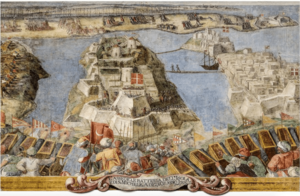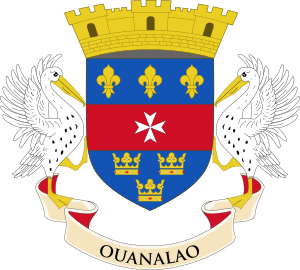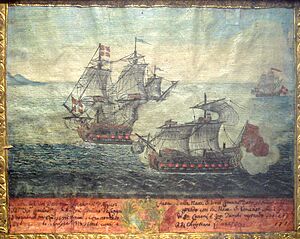Hospitaller Malta facts for kids
Quick facts for kids
Hospitaller Malta
|
|||||||||||||||||
|---|---|---|---|---|---|---|---|---|---|---|---|---|---|---|---|---|---|
| 1530–1798 | |||||||||||||||||
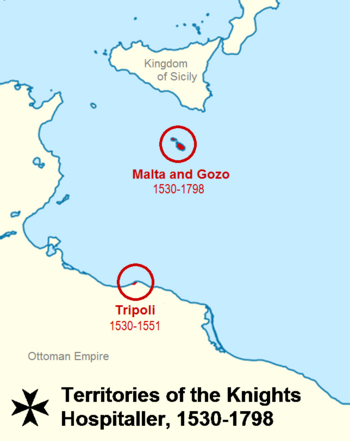
Map of Malta and Gozo in relation to Sicily and Hospitaller Tripoli
|
|||||||||||||||||
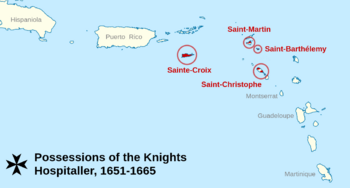
Map of the Order's territories in the Caribbean
|
|||||||||||||||||
| Status | Vassal state of the Kingdom of Sicily (1530–1753) Sovereignty proclaimed in 1753 |
||||||||||||||||
| Capital | Birgu (1530–1571) Valletta (1571–1798) |
||||||||||||||||
| Common languages | Italian, Latin (official) Maltese (unofficial) |
||||||||||||||||
| Religion | Roman Catholicism | ||||||||||||||||
| Demonym(s) | Maltese | ||||||||||||||||
| Government | Theocratic elective monarchy | ||||||||||||||||
| Grand Master | |||||||||||||||||
|
• 1530–1534
|
Philippe Villiers de L'Isle-Adam (first) | ||||||||||||||||
|
• 1797–1798
|
Ferdinand von Hompesch zu Bolheim (last) | ||||||||||||||||
| Historical era | Early modern period | ||||||||||||||||
| 24 March 1530 | |||||||||||||||||
|
• Established
|
26 October 1530 | ||||||||||||||||
| 15 August 1551 | |||||||||||||||||
| 21 May 1651 | |||||||||||||||||
|
• Sale of Caribbean territories
|
1665 | ||||||||||||||||
|
• Proclamation of sovereignty
|
1753 | ||||||||||||||||
| 12 June 1798 | |||||||||||||||||
| Area | |||||||||||||||||
|
• Total
|
316 km2 (122 sq mi) | ||||||||||||||||
| Population | |||||||||||||||||
|
• 1530 (estimate)
|
33,000 | ||||||||||||||||
|
• 1632 (census)
|
51,750 | ||||||||||||||||
|
• 1741 (estimate)
|
110,000 | ||||||||||||||||
| Currency | Maltese scudo |
||||||||||||||||
| ISO 3166 code | MT | ||||||||||||||||
|
|||||||||||||||||
|
Area and population excluding Tripoli and the Caribbean islands
|
|||||||||||||||||
Hospitaller Malta was a time when the islands of Malta and Gozo were ruled by a group called the Knights Hospitaller (or Order of St. John of Jerusalem). This period lasted from 1530 to 1798. It was like a smaller state under the Kingdom of Sicily.
The Knights got the islands from Emperor Charles V. This happened after they lost their previous home in Rhodes in 1522. They also received the city of Tripoli in modern Libya. The Knights lost Tripoli to the Ottoman Empire in 1551. But a big attack by the Ottomans on Malta in 1565 failed.
After this important battle, the Knights decided to stay in Malta for good. They started building a new capital city called Valletta. For the next 200 years, Malta had a "Golden Age." This meant art, buildings, and society got much better. In the mid-1600s, the Knights even owned some islands in the Caribbean. This made them the smallest state to have colonies in the Americas.
The Order started to become weaker in the 1770s. The French Revolution in 1792 made things even worse. In 1798, French forces led by Napoleon took over Malta. They forced the Knights to leave. The Maltese people later fought back against the French. In 1800, Malta became a British protectorate. The Treaty of Amiens in 1802 said Malta should go back to the Knights. But the British stayed in control. Malta officially became a British colony in 1814.
Contents
The Knights Arrive in Malta (1500s)
Early Years on the Islands
The Knights of Saint John had to leave their base in Rhodes in 1522. This was because of a siege by the Ottoman Empire. For seven years, they moved around Europe. Finally, in 1530, Emperor Charles V gave them Malta, Gozo, and the port of Tripoli. He gave them these lands forever. In return, the Knights had to send one Maltese falcon every year to the King of Sicily.
The Knights made the town of Birgu their capital. They rebuilt an old fortress called Castrum Maris into Fort Saint Angelo. They also made the town's defenses stronger. Many new buildings were constructed. The Knights soon started making their own coins.
The Knights continued to fight against Muslim forces, especially Barbary pirates. Even though they had few ships, they soon angered the Ottoman Empire. The Ottomans did not like that the Knights had settled in Malta. In July 1551, Ottoman forces tried to take Fort Saint Angelo. They also tried to take Mdina. But they saw they were outnumbered. A few days later, they invaded Gozo. Then they sailed to Tripoli and captured the city in August.
After these attacks, the Knights tried to bring more people to Gozo. They also made the Grand Harbour defenses stronger. They built forts like Saint Elmo and Saint Michael. The city of Senglea grew around Fort Saint Michael.
Between 1551 and 1556, a terrible tornado hit Malta. It destroyed at least four of the Knights' ships. It also killed 600 people. This was one of the worst natural disasters in Malta's history.
The Great Siege of Malta
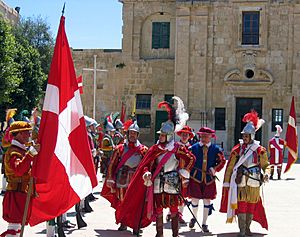
In 1565, the Ottoman leader Suleiman sent a huge army of about 40,000 men. Their goal was to remove the Knights from Malta. The Knights had only 700 knights and 8,000 soldiers. At first, the battle went badly for the Knights. Most cities were destroyed, and about half the knights were killed. By August 18, the situation was very serious. The Knights were losing men daily. They were too weak to defend the long lines of fortifications.
The Grand Master, Jean Parisot de Valette, refused to give up. His council suggested leaving Birgu and Senglea. They wanted to retreat to Fort St. Angelo. But de Valette said no.
The Viceroy of Sicily had not sent help. He might have been worried about weakening his own defenses. But he had left his own son with de Valette, so he cared about the fortress. Whatever the reason, the Viceroy waited until the Knights had almost won the battle on their own. Only then did he send help.
On August 23, the Ottomans launched another big attack. It was their last serious effort. The Knights fought them back with great difficulty. Even wounded soldiers helped defend the forts. But the Ottoman forces were now in a desperate situation. Except for Fort Saint Elmo, the forts were still standing. The Knights worked day and night to fix any damage. Taking Malta seemed more and more impossible for the Ottomans.
Many Ottoman soldiers got sick during the hot summer. They were also running out of ammunition and food. The Ottoman troops became very discouraged. Their attacks kept failing, and they had lost many men. The death of their skilled commander, Dragut, on June 23 was a big blow. The Turkish commanders were careless. They had a huge fleet but used it effectively only once. They also failed to keep in touch with their bases in Africa. They did not try to stop the Sicilian reinforcements.
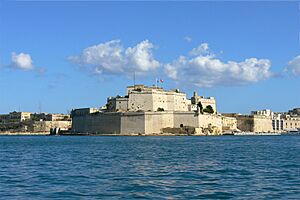
On September 1, the Ottomans made their final attempt. But their soldiers' morale was very low. The attack was weak. This greatly encouraged the Knights, who now saw hope. The confused Ottomans heard that Sicilian reinforcements had arrived. They did not know the force was very small. So, they ended the siege and left on September 8. The Great Siege of Malta might have been the last time a force of knights won such a big victory.
When the Ottomans left, the Knights had only 600 men left who could fight. The Ottoman army had been about 40,000 men at its peak. Only 15,000 returned to Constantinople. The siege is shown in colorful paintings by Matteo Perez d'Aleccio. These paintings are in the Grandmaster's Palace in Valletta.
After the siege, a new city was built. It was named Valletta to honor the Grand Master. It became the Knights' main base in 1571. It is still Malta's capital city today.
In 1574, the Roman Inquisition started in Malta. This was when Pope Gregory XIII sent Pietro Dusina. He was sent to help solve problems between the Grand Master and the Bishop. This new inquisition replaced an older one in Malta.
Malta in the 1600s
Building and Defending Malta
Between 1610 and 1615, the Wignacourt Aqueduct was built. It brought water from Dingli and Rabat to the capital city, Valletta. This aqueduct was used until the early 1900s. Most of its arches are still standing today.
Throughout the 1600s, Malta's defenses were also improved. Large parts of Gozo's Cittadella were rebuilt between 1599 and 1622. The Grand Harbour area was made stronger. The Floriana Lines and Santa Margherita Lines were built in the 1630s and 1640s. These lines of defense surrounded Valletta, Birgu, and Senglea. Later, the Cottonera Lines were built around the Santa Margherita Lines. This happened between 1670 and 1680. Because of a lack of money, these lines were not finished for many years.
In the late 1600s, Fort Ricasoli was built. It protected the entrance to the Grand Harbour. Fort Saint Elmo and Fort Saint Angelo were also made stronger.
Even with these strong defenses in the harbor, most of the coastline was still unprotected. In 1605, Garzes Tower was built on Gozo. In the following years, Alof de Wignacourt built more coastal defenses. He built the Wignacourt towers, which were six watchtowers. Later, Grand Master Lascaris built several smaller towers. His successor, de Redin, also built a series of similar towers. The last coastal tower built was Isopu Tower in 1667.
In 1693, an earthquake damaged many buildings in Malta. The old cathedral in Mdina was destroyed. A new Baroque cathedral was built in its place starting in 1697.
In the 1600s and early 1700s, the Knights' navy was very strong. The Order often fought naval battles against the Ottomans. They took part in battles like the action of 28 September 1644 and the Battle of the Dardanelles in 1656. They also fought in the Battle of Lepanto in 1571. Piracy also became an important part of Malta's economy until the early 1700s.
Knights in the Americas
The Knights also took part in the colonization of the Americas. On May 21, 1651, they bought four islands in the Caribbean. These islands were Saint Barthélemy, Saint Christopher, Saint Croix, and Saint Martin. They bought them from a French company that had just closed down. The Knights controlled these islands until 1665. Then, they sold the four islands to the French West India Company. This was the end of the Knights' influence outside the Mediterranean Sea.
Malta in the 1700s
New Forts and Baroque Style
After the War of the Spanish Succession, the Treaty of Utrecht in 1713 gave Sicily to the Duke of Savoy. He became the new ruler of Malta. Seven years later, the Treaty of The Hague reunited Naples and Sicily.
From 1714 onwards, about 52 batteries and redoubts were built. These were along with several trenches. They were built around the coasts of Malta and Gozo. Other important forts built in the 1700s include Fort Chambray on Gozo. It was built between 1749 and the 1760s. Fort Tigné in Marsamxett was built between 1792 and 1795.
Throughout the 1700s, Baroque architecture was very popular in Malta. This style is often linked to Grand Masters António Manoel de Vilhena and Manuel Pinto da Fonseca. Both of them were from Portugal. During de Vilhena's time, the city of Mdina was greatly changed in the Baroque style. Other important Baroque buildings from his time include Fort Manoel and the Manoel Theatre. The town of Floriana also started to grow around this time.
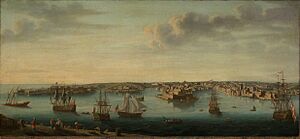
During Pinto's time (1741-1773), the Baroque style was still very strong. Buildings from this time include Auberge de Castille and the Valletta Waterfront.
In 1749, there was a planned revolt by Turkish slaves. They wanted to kill Pinto. But their plans were discovered before they could start.
In 1753, Pinto declared that the Order was sovereign over Malta. This meant they were fully independent. A disagreement started with the Kingdom of Sicily. The dispute ended a year later, in 1754. Sicily and the Order returned to normal relations. But Sicily no longer had any control over Malta. Malta, under the Order, became an independent state.
Decline of the Order
In the last 30 years of the 1700s, the Order slowly became weaker. This happened for several reasons. One reason was that Pinto's expensive rule had used up all the Order's money. Because of this, the Order also became unpopular with the Maltese people.
In 1775, during the rule of Francisco Ximénez de Tejada, a revolt happened. It was called the Rising of the Priests. Rebels managed to capture Fort St Elmo and Saint James Cavalier. But the revolt was stopped. Some leaders were executed, while others were jailed or sent away.
In 1792, the French state took over the Order's properties in France. This was due to the French Revolution. This made the Order's financial problems even worse. When Napoleon landed in Malta in June 1798, the Knights could have fought for a long time. But they gave up the island almost without a fight. The French then occupied Malta until 1800. Then, Maltese revolutionaries, helped by Great Britain, forced them out.
Malta became a British protectorate. The Treaty of Amiens said Malta should be given back to the Order. But this never happened. The new Grand Master, Giovanni Tommasi, asked the British to give back the Grandmaster's Palace in Valletta. But the British said they could keep troops on the island. They said some powers still did not recognize Malta's independence.
Malta eventually became a British colony in 1813. It remained a colony until it gained independence in 1964. The Order itself spread out across Europe. But in the early 1800s, it focused on helping people and religious causes. In 1834, the Order, now called the Sovereign Military Order of Malta, set up its main office in Rome. It is still there today.
See also
 In Spanish: Malta hospitalaria para niños
In Spanish: Malta hospitalaria para niños
- Hospitaller Rhodes
- Kingdom of Sicily
- List of Knights Hospitaller sites




